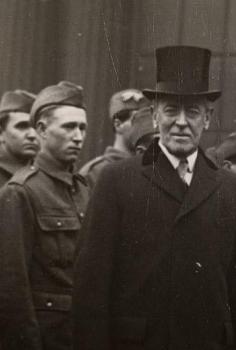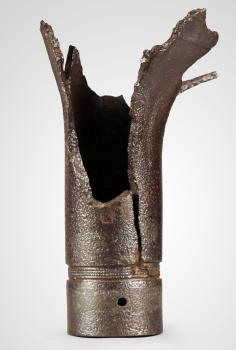“I escaped only yards from being prisoner and by several miracles from being killed… My altar kit I had to drop myself or I should have been gone. I thank God I am through so far – that is all I can say words are useless to describe it.”
—Father John Fitzgibbon, 23rd and 16th Field Ambulance, British Expeditionary Force
During the difficult days of the Great War, maintaining faith and spiritual comfort took on new importance for many service members far from home. A British Army chaplain carried this field Communion set as he traveled the front lines to perform services and offer counseling to troops in the trenches, encampments and field hospitals.

To rotate, left click+drag or one-finger drag. To zoom in, double click or pinch. To pan, right click+drag or two-fingers drag.
A field Communion set, also referred to as an altar kit or chaplain’s kit, often looks like a briefcase with special objects nestled inside. The compact, portable kits allowed chaplains to bring the spiritual comfort of sacraments to service members wherever they were stationed, even under active bombardment. The contents varied depending on whether the chaplain carrying it was Roman Catholic or Anglican. These portable kits could include:
Chalice
A small metal cup, usually gold or silver, used for Holy Communion (Eucharist) to hold wine.

Paten
A small plate or disc used to hold the consecrated bread (or “host”) for Communion.

Wine Ewer
A small pitcher made of glass or metal that ensures the wine does not come into contact with hands during consecration or pouring.

Crucifix
A small cross with Christ enduring crucifixion that is worn, carried or displayed by the chaplain as a religious emblem of sacrifice and redemption.

Stole
A narrow scarf or band of cloth draped around the chaplain’s neck, denoting their sacred role during services or sacraments.

Prayer book
A miniature book of common prayers, psalms and religious texts to guide worship services.

Ciborium
A container used for consecrated communion hosts, with a lid to prevent spilling during transport.

Holy water
Small vials or containers of blessed water used in rituals like baptism or blessing of grave sites.

Candles
Compact-sized candles and candlesticks as a reminder of the light of Christ during services.

Chrism
A consecrated oil used for the anointing of the sick or dying in confession or last rites.

Chaplains faced immense challenges bringing spiritual relief to service members amid the horrors of industrialized warfare. In situations where chaplains often had to arrange makeshift altars – using whatever was on hand like artillery boxes or upturned water cans – field sets were vital in providing transportation for and care of items necessary to celebrate sacraments. These celebrations of grace, faith and blessings offered troops a means to remember life beyond the battlefield and find strength in faith.
An initiative of The Center for Religion, Culture and the Great War, made possible through generous support from Lilly Endowment Inc.









